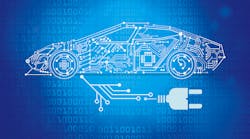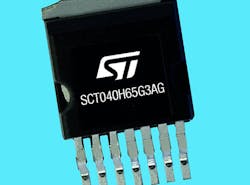Third Generation of SiC MOSFETs Arrives for EV Apps
Check out our CES 2022 coverage.
What you'll learn:
- Advantages of SiC-based over silicon-based semiconductors.
- New figure-of-merit benchmarks for the latest STMicroelectronics SiC MOSFETs.
- Primary electric-vehicle applications.
With the acceleration of the electric-vehicle (EV) market, many car makers and automotive suppliers are now embracing 800-V drive systems to increase efficiency, achieve faster charging, and expand the range of such vehicles, all while reducing weight and cost. Wide-bandgap (WBG) devices, such as SiC MOSFETs, are helping automakers advance the state-of-the-art in power devices for EV powertrains and other applications where such factors are important criteria.
SiC power devices have found application in critical power systems inside EVs, including traction inverters, on-board chargers (OBCs), and in the dc-dc conversion stage. Key benefits over conventional silicon devices include their higher-voltage and higher-frequency capabilities, allowing for greater system efficiency, faster switching, lower losses, and better thermal management.
With respect to their silicon-based counterparts, SiC devices offer the following advantages:
- Over 600 km longer driving range on an average EV
- 150 to 200 kg less weight on an average EV
- Double the energy from a charging station
- Longer battery lifetime due to lower stress
Compared to silicon alternatives, SiC MOSFETs also maintain a higher voltage rating in relation to their die size, suiting the technology to EV applications and fast-charging EV infrastructures. What’s more, existing designs can incorporate the performance and efficiency benefits of SiC devices without major changes, enabling fast development turnaround while keeping the bill of materials to a minimum.
In addition, SiC MOSFETs benefit from a very fast intrinsic diode that delivers the bidirectional properties needed for automotive OBCs used in vehicle-to-everything (V2X) power flow. This allows for the transmission of electricity from an OBC battery to the infrastructure.
Third-Gen SiC Platform
STMicroelectronics just recently announced it completed qualification of a third-generation SiC technology platform and expects to move most of the derivative products to commercial maturity by the end of 2021. “We are investing relentlessly to support our automotive and industrial programs expected to generate $1 billion in SiC revenue in 2024,” said Edoardo Merli, Power Transistor Macro-Division General Manager and Group Vice President of STMicroelectronics’ Automotive and Discrete Group.
The new ST devices will have nominal voltage ratings from 650 V and 750 V up to 1200 V. They will give designers more choices to address applications operating from ordinary ac-line voltages up to those of high-voltage EV batteries and chargers, including 800-V types.
The first products available are the 650-V SCT040H65G3AG and the 750-V SCT160N75G3D8AG. Third-generation devices will be offered in packages including STPAK, H2PAK-7L, HiP247-4L, and HU3PAK. The packages offer design features such as specially placed cooling tabs that simplify connection to baseplates and heat spreaders in EV applications.
According to ST, its latest MOSFETs set new industry-leading benchmarks for the accepted figures-of-merits (FOMs)—on-resistance (RDS(on)) × die size, and RDS(on) × gate charge (Qg)—that express transistor efficiency, power density, and switching performance. Bettering FOMs using ordinary silicon technology has become increasingly difficult and, as a result, SiC technology holds the key to further improvement.
Array of Applications
EV applications include:
Main inverter electric traction
Electric vehicles rely on traction inverters to convert the high-voltage dc energy stored in the vehicle’s batteries to drive the ac traction motors. The traction inverter plays a crucial role in driving the vehicle and needs to be extremely robust and reliable, given the high power switching and likely high dv/dt transients involved.
The traction inverter converts energy from the vehicle's battery to drive the motors in the drivetrain. This key component has a direct impact on road performance, driving range, and reliability of the vehicle, also due to their weight and size. Subject to all of the possible stress found in a road vehicle from heat and vibrations, these converters must be able to handle high power and currents along with the associated electromagnetic-compatibility (EMC) challenges, as well as provide fail-safe operation to ensure dependability and safety for the driver and passengers.
DC-DC converters for EVs/HEVs
In the various configurations of EVs, dc-dc converters convert high voltage to 48 V, high voltage to 12 V, and 48 V to 12 V. The key design requirements for dc-dc converters are low losses, high efficiency, low volume, and light weight.
EVs use two different power systems: a high-voltage battery (200 to 450 V dc) for traction and a low-voltage battery to supply all of the electric appliances in the vehicle. Traditionally, the low-voltage battery was charged from the alternator, but in today's vehicles, it gets its power from the high-voltage battery pack.
However, in specific electric car architectures, this low-voltage battery should be ready to help recharge the high-voltage battery pack to provide energy for cranking the car. This means that the on-board dc-dc converter must be bidirectional and very efficient, as well as highly reliable, to run the complex control algorithms needed to ensure an energy-efficient solution.
On-board chargers
The OBC provides the means to recharge the battery from the ac mains either at home or from outlets found in private or public charging stations. From a 3.6-kW single-phase to a 22-kW three-phase high-power converter, today’s OBCs must have the highest possible efficiency and reliability to ensure rapid charging times as well as meet the limited space and weight requirements.
Moreover, their very-high-frequency capability allows for smaller passive components within power systems, which permit more compact and lightweight electrical equipment in the vehicle.
On that front, ST developed the SCT040H65G3AG, an automotive-grade SiC power MOSFET with 650 V, 40 mΩ (typical), 30 A in an H2PAK-7 package. The device features a low RDS(on) over the entire temperature range (40 mΩ typ., 55 mΩ max.) combined with low capacitances and very high switching operations, which improve application performance in terms of frequency, energy efficiency, system size, and weight reduction.

